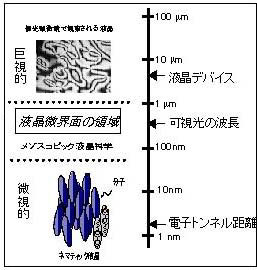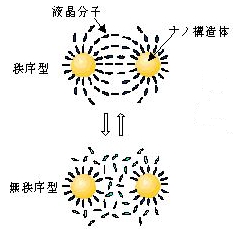


Ordinary liquid crystals have a density similar to that of water and are somewhat opaque due to many defects. However, if a 5 - 10 micrometer thick layer of a liquid crystal material is sandwiched between glass plates whose surfaces have been carefully prepared by buffing in one direction, a defect-free layer single crystal is obtained. This process, known since the turn of the century, is more art than science, in that the detailed physics of the procedure is not yet understood. These liquid crystals then respond to applied electro-magnetic fields to display information.
The basic point that makes the liquid crystalline state unique is spontaneous assembly in a variety of different structures without any organized commands from outside.

Because liquid crystals interact very strongly at surfaces, nanoscopic tailored structures can be created that can interact with them. These interactions can be used as a kind of probe or stimulus to which the liquid crystal responds in a particular manner. The initial approach is to probe into the resulting structural changes over length scales from nanometer to 100 nanometers, or from individual molecules to large-scale assemblies of molecules, by means of a variety of microanalytical techniques. The "pump-and-probe" approach, with the aid of theoretical and computational studies, can be extremely powerful in exploring the hierarchical structure formation in liquid crystals.
As a good example of this "top-down" approach, a scanning-probe technology is being used to produce very specific substrates with various structures on the 10-nanometer scale upon which to lay down a liquid-crystal layer. These include rows of dots or other structures, which should produce very different surface states having different interactions with liquid crystals. It should thus be possible to study how a macroscopic surface alignment results from a specific molecular arrangement of liquid crystals over the nanometer scale.
Another interesting approach being used is self-organization involving the random dispersion of small particles inside a liquid crystal. For a particle as small as 10 nanometers, the inter particle separation can also be equally small. If that length is chosen to match again the length scale of the hierarchical molecular arrangement in the liquid crystal, different information about the genesis of liquid crystals can be deduced from the intricate spontaneous arrangement of particles. The liquid-crystal orientation at the surface of these particles can be made perpendicular, or planar or even changeable, sometimes by using electric fields and photo-excitation. This new state of liquid crystals can perhaps be called "mesoscopic liquid crystals," as opposed to ordinary homogeneous liquid crystals. In the nano-structured liquid crystal, novel structural transitions can emerge and it should be possible to tune such characteristics as the refractive index or birefringence and elastic constant, thus making very soft liquid crystals that can be used as an ultra sensitive detectors for various physical and chemical changes.